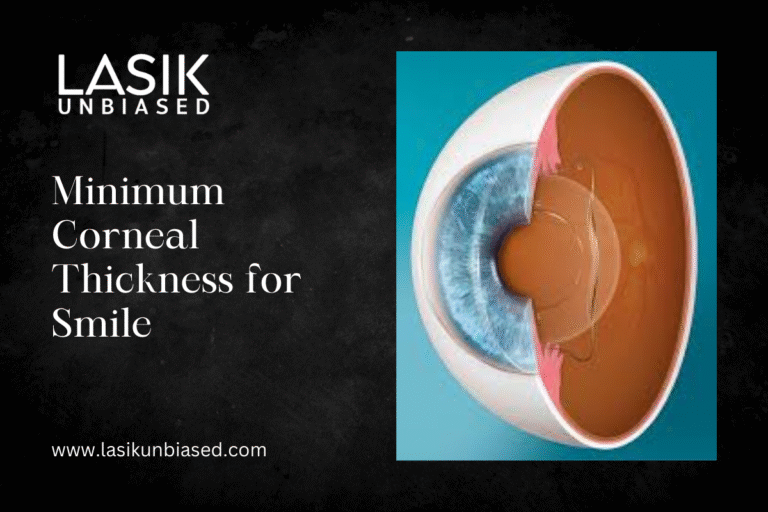SMILE eye surgery typically requires a minimum corneal thickness of 500 microns, though some studies have shown it to be safe and effective in patients with corneal thickness between 475–500 microns.
During the consultation, the surgeon will assess your corneal thickness to determine your eligibility as a suitable candidate.
Small Incision Lenticule Extraction (SMILE) is a revolutionary advancement in refractive eye surgery. Unlike LASIK, SMILE is minimally invasive and works to correct myopia (nearsightedness) and astigmatism with minimal downtime. However, one critical factor that determines eligibility for the procedure is corneal thickness. The cornea plays a pivotal role in ensuring the safety and effectiveness of SMILE surgery. Understanding the minimum corneal thickness requirements is essential for anyone considering the procedure.
Why is Corneal Thickness Important for SMILE?
The cornea is the transparent, dome-shaped surface at the front of your eye. It helps refract light to facilitate clear vision. During SMILE surgery, a small piece of corneal tissue (known as the lenticule) is removed to reshape the cornea and correct refractive errors. Removing a lenticule reduces corneal tissue thickness, which has to be carefully managed to preserve corneal strength and health.
A minimum corneal thickness is necessary to ensure structural integrity and safety post-surgery. Thin corneas increase the risk of complications, such as keratoconus (a condition where the cornea weakens and bulges) or suboptimal surgical outcomes.
The Minimum Corneal Thickness Requirement
While 500 microns is generally recommended for SMILE surgery, certain cases with corneal thickness slightly below this threshold (e.g., 475–500 microns) may still be considered suitable based on individual assessments.
This allows enough residual corneal tissue to remain intact after the procedure, maintaining stability and preventing abnormalities.
This figure is not arbitrary but is based on thorough research and clinical studies. Maintaining sufficient residual corneal thickness minimises the risk of long-term complications and ensures the procedure delivers optimal results.
How is Corneal Thickness Measured?
Before undergoing SMILE, your ophthalmologist will conduct a series of tests to evaluate whether you are a suitable candidate. Measuring corneal thickness is a critical part of this evaluation. Here’s how it’s done:
1. Pachymetry
Pachymetry measures corneal thickness—usually at the center, but some advanced systems can assess peripheral areas as well. It is performed using an ultrasonic pachymeter or non-contact methods such as optical coherence tomography (OCT) or Scheimpflug imaging.
Ultrasound pachymeters use a handheld probe to emit sound waves that measure central corneal thickness. OCT uses light waves and provides cross-sectional imaging, offering greater detail and precision in mapping corneal layers.
2. Corneal Topography
Corneal topography maps the entire surface of the cornea, assessing both thickness and curvature. This ensures there are no irregularities or conditions like keratoconus that might disqualify a candidate from undergoing SMILE.
3. Tomography
Corneal tomography provides 3D imaging that reveals both anterior and posterior corneal surfaces, thickness distribution, and elevation data—critical for detecting early signs of corneal diseases such as keratoconus. Advanced technologies such as Pentacam or Orbscan are commonly employed for this purpose.
These diagnostic tools allow surgeons to ensure that the surgery can be performed safely and that a sufficient residual corneal thickness will remain after the procedure.
Factors that Affect Corneal Thickness
Corneal thickness varies among individuals and is influenced by several factors. Here are some important considerations:
1. Genetics
Corneal thickness often has a hereditary component. If thin corneas run in your family, it’s possible you may have thinner corneal tissue, potentially disqualifying you from SMILE surgery.
2. Age
Corneal thickness can decrease slightly with age, and changes in biomechanical properties may also occur. Elderly patients may require comprehensive screening to assess corneal stability prior to undergoing surgery.
3. Existing Eye Conditions
Conditions such as keratoconus or corneal ectasia, where the cornea is weak or irregularly shaped, can render SMILE surgery unsafe. These conditions lead to significantly thinner corneas and may compromise postoperative outcomes.
4. Environmental Factors
Short-term fluctuations in hydration status or ambient humidity can slightly influence corneal thickness measurements, although these changes are generally minor and temporary.
What Happens if Your Corneal Thickness is Less Than 500 microns?
For patients with corneal thickness below 475 microns, SMILE is generally not recommended due to the increased risk of postoperative complications. However, this doesn’t mean you are automatically disqualified from vision correction surgery. Here are some alternative options your surgeon may consider:
1. Photorefractive Keratectomy (PRK)
PRK is an alternative to SMILE and LASIK for individuals with thin corneas. Instead of cutting a corneal flap, PRK involves removing the top layer of the cornea (epithelium) to reshape it. It’s often considered a safer option for those with thinner-than-average corneas.
2. Implantable Collamer Lenses (ICL)
For patients with very thin corneas, ICL surgery is another highly effective option. ICL involves implanting a lens inside the eye to correct refractive errors, without removing or reshaping corneal tissue.
3. Customised Treatment Plans
Corneal collagen cross-linking (CXL) can be used to stabilise the cornea in conditions like early keratoconus. While not typically performed solely for thin corneas, it may be part of a combined approach in selected cases. Your surgeon may develop a tailor-made solution based on your specific eye anatomy and needs.
Can you Improve your Corneal Thickness?
While corneal thickness cannot be naturally increased, procedures like corneal collagen cross-linking (CXL) can strengthen the cornea, especially in patients with conditions like keratoconus. However, CXL does not thicken the cornea—it enhances structural stability, which may help preserve vision and potentially support eligibility for certain treatments.
Corneal health can be maintained by protecting your eyes from harmful environmental factors and avoiding behaviours that may weaken the cornea over time, such as excessive eye rubbing. Consulting an ophthalmologist early and following their recommendations is key to safeguarding long-term corneal integrity.
Why does Residual Corneal Thickness Matter?
After removing the lenticule during SMILE surgery, there must be a sufficient amount of corneal stroma remaining for the eye to function properly. Maintaining a residual stromal bed thickness of at least 250 microns is crucial to preserve corneal strength and minimise the risk of ectasia.
If too much tissue is removed, the cornea’s biomechanical stability can be compromised, increasing the risk of long-term complications.
Final Thoughts for SMILE Candidates
Understanding the importance of corneal thickness is a crucial step if you’re considering SMILE eye surgery. Meeting the 500-micron threshold ensures that the procedure is not only effective but also safe for your long-term eye health.
If your corneal thickness doesn’t meet the minimum requirement, don’t despair. Multiple alternatives exist that may still be suitable for your needs. Always consult a qualified ophthalmologist to explore these options.
Vision correction is a life-changing decision. Ensure your path to clearer sight starts with well-informed choices and personalised professional guidance.


